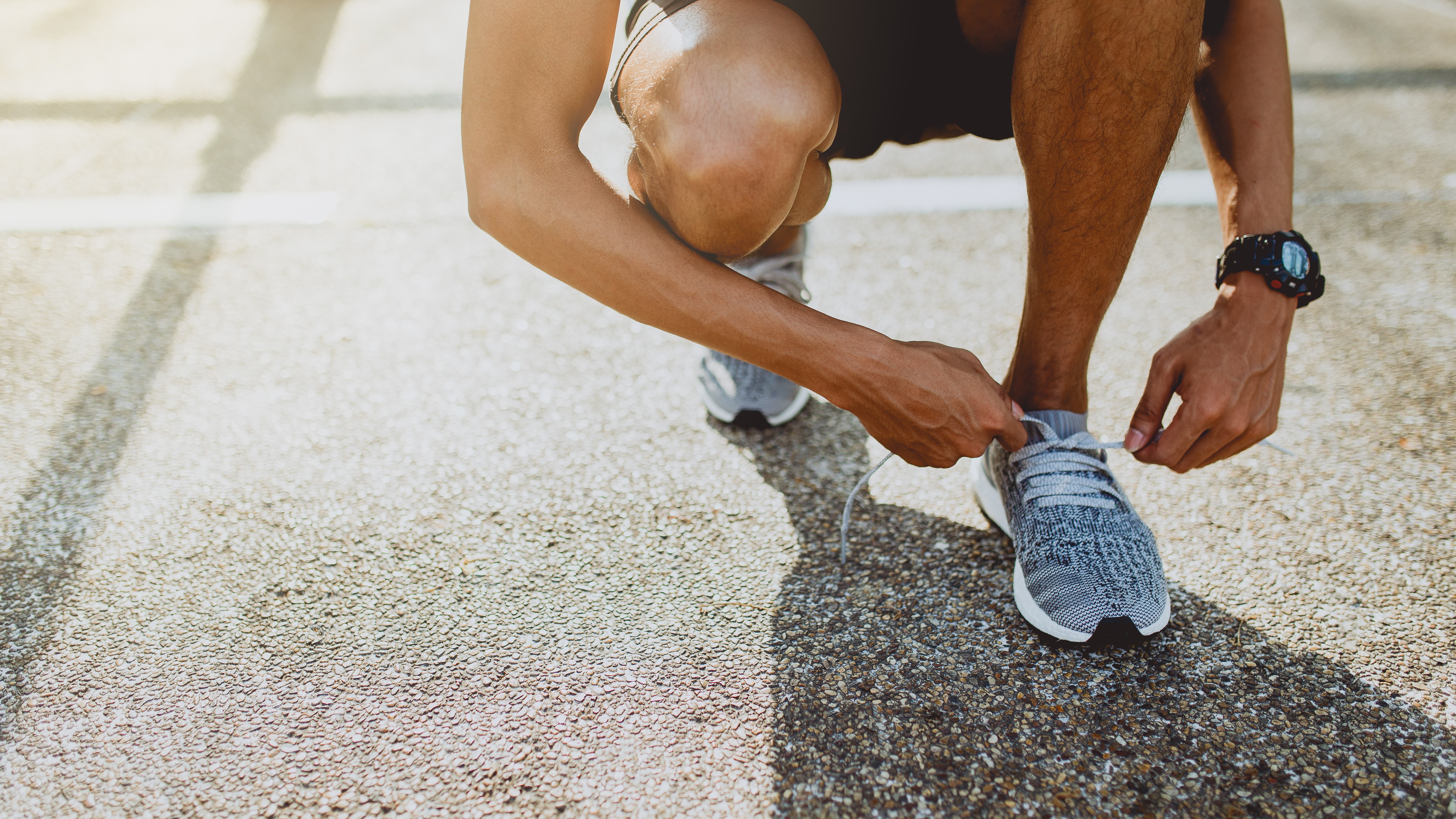How to buy running shoes
Want to know how to buy running shoes, including your first pair? Here's what you need to know

When it comes to knowing how to buy running shoes, including your first pair, the choice and jargon can seem overwhelming.
Should you buy the same size as your Converse? What does ‘zero drop’ mean and if you’re buying online, how should your new running shoes fit when they arrive? Well, we have you covered.
- These are the best Nike running shoes to buy today
- Here's how to clean white shoes
Here’s everything you need to know when it comes to buying running shoes, whether they're your first pair or you're looking to upgrade. And if you're ready to make your decision then here's our list of the best women’s running shoes.
How should running shoes fit?
Your running shoes should not be the same size as your Converse or casual trainers. As you run, your toes will move further towards the front of the shoe, meaning you’ll need a thumb width of space to prevent injuries (black toenails, we’re looking at you). You’ll also want to make sure you can wiggle your toes without your little toe rubbing against the side of the shoe; if they do, chances are you’ll need a shoe with a wider width.
Also, chances are that over time your feet will get slightly bigger as the muscles stretch with the impact of regular running. This might mean that your running shoe size might change and you might need to go up half or even a full shoe size.
One of the easiest ways to ensure you’re running in the right shoes is to get your foot measured in a running shop. Some stores have machines that can analyze your running gait, but at the very least, a store employee should look at how you walk or run. If this isn’t an option, before buying your first pair of running shoes, physically measure your foot by drawing around it on a piece of paper. This will help you get a better idea of your shoe size and will come in handy when looking at brand’s size guides.
Another thing to look out for is the slight differences between running shoe brands. Just because you’re a size 9 in Nike running shoes, doesn’t mean you’ll need a size 9 in Asics running shoes, so it’s worth checking the company’s size guide before you buy.
Sign up to get the BEST of Tom's Guide direct to your inbox.
Get instant access to breaking news, the hottest reviews, great deals and helpful tips.
How long should a pair of running shoes last?
As a rule of thumb, your new running shoes should last you around 400 miles, however, this will vary depending on how you run, where you run and how often you’re slipping on your shoes. If you’re wearing your running shoes to walk the dog or to go to the gym, they might not last as long as if you’re only wearing them when pounding the pavements. Ideally, you should only wear your running shoes while you’re, you know, running.
Running shoes ‘wear out’ as the midsole gets compressed. Often, running shoes will feature a layer of springy foam that, over time, will get squished down to a point where it won’t bounce back, making them less effective. It’s also worth noting, modern shoes kitted out with lightweight layers of foam and carbon fiber plates might not last as long as more traditional running shoes with sturdier, thicker soles.
Some runners will track the amount of mileage their shoes have done in apps like Strava. And other modern shoes have Bluetooth chips that keep a tab on how many miles the shoe has clocked. If you’re not that technically savvy, or you’re reading this after owning your shoes for years, the tell-tale signs you need to upgrade your running shoes are holes or tears in the upper, or once the design on the outsole starts to disappear. If you’re suddenly noticing aches in your ankles, calves, or knees, it might be a sign that your shoes aren’t supportive enough anymore.
What does ‘Zero drop’ mean?
The ‘drop’ of a running shoe refers to the height difference between the heel of the shoe and the forefoot. Some shoes will have ‘zero drop,' meaning there is literally zero drop, making them extremely flat to the ground. These are often popular with runners who prefer minimalist shoes or that running barefoot feeling, but if they won’t be for everyone.
Are running shoes good for walking?
Yes and no. There’s absolutely no reason why you can’t or shouldn’t walk the dog wearing your running shoes, but be aware this might shorten the lifespan of your shoe. Also, if you’re planning on wearing your road running shoes with you on a hike, they might not offer the same ankle support or grip as say, a walking shoe or boot.
Are running shoes waterproof?
Rarely. Even trail running shoes will be fast-drying and water-resistant rather than fully waterproof as you want the running shoe to be breathable. Most running shoe uppers will be designed to hold onto as little water (and sweat) as possible, so they remain lightweight and comfortable. That said, there will be some trail running shoes on the market with breathable uppers.
What does ‘neutral’ mean?
Good question. In the past, running brands tended to divide their shoes into two different categories: ‘neutral’ and ‘stability'. This was related to whether or not your foot rolled in too far over your ankle as your foot hit the ground (referred to as overpronation). Stability shoes traditionally had a hard, medial post that ran along the inside arch of the shoe. These days, a lot of running brands are moving away from these categories and support has got a lot smarter, but running shoes will still fall into one of these two categories.
A neutral shoe is often one that is flexible and cushioned, suited to runners who don’t especially overpronate (when your foot rolls inward as you move) when they run. If you have medium to high arches, you’ll normally find a neutral shoe is more comfortable. But again, the best way to know for sure is to have your gait analyzed.
There are also plenty of insoles on the market that promise to correct overpronation. But alongside this is a large body of recent research that suggests strengthening the foot and leg muscles is more effective in the long run (pun intended), so it’s a good idea to seek professional advice before buying.
Do men’s and women’s shoes fit differently?
There’s a long-running myth in the running shoe industry that brands make the same shoes for men and women, the women’s running shoes are just pink. This isn’t correct. Women’s feet are often smaller and narrower than men and there are studies that suggest women’s feet are more flexible, so the shoes will often fit accordingly. Although the differences might not be noticeable to the naked eye, there will often be minute variations in terms of the fit, construction, and cushioning used for men’s and women’s running shoes.
That said, more and more these days some of the higher-end racing shoes will be labelled as ‘unisex’ and women can opt to wear men’s shoes if they find them more comfortable. The golden rule is for the shoes to feel good on your feet, so try not to worry about what they look like or what size they are.
Next: I walked 50 miles in the Skechers Go Walk shoes and here's how they fared.
Get healthy and in shape with our other fitness gear guides:
Wearables
Best smartwatches | Best running watches | Best Garmin watches | Best sports watches | Best fitness trackers | Best Fitbit | Best cheap running headphones | Best running headphones
Workout equipment
Best treadmills | Best adjustable dumbbells | Best home gym equipment | Best resistance bands | Best foam rollers | Best yoga mats | Best weighted jump ropes | Best smart scales | Best shoes for Peloton and indoor cycling
Apps and exercises
Best workout apps | Best running apps | Best 10-minute ab workout | How to lose belly fat | Best tabata workouts | Best 30-minute workouts | Best beginner HIIT workouts

Jane McGuire is Tom's Guide's Fitness editor, which means she looks after everything fitness related - from running gear to yoga mats. An avid runner, Jane has tested and reviewed fitness products for the past five years, so knows what to look for when finding a good running watch or a pair of shorts with pockets big enough for your smartphone. When she's not pounding the pavements, you'll find Jane striding round the Surrey Hills, taking far too many photos of her puppy.
